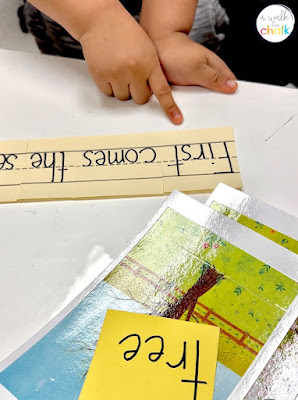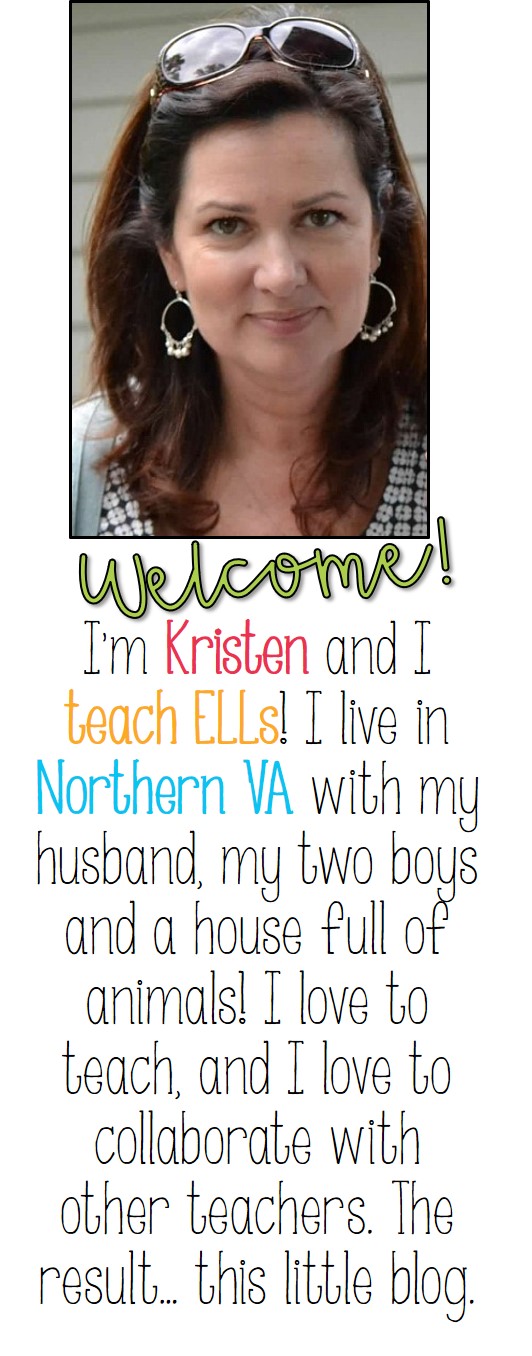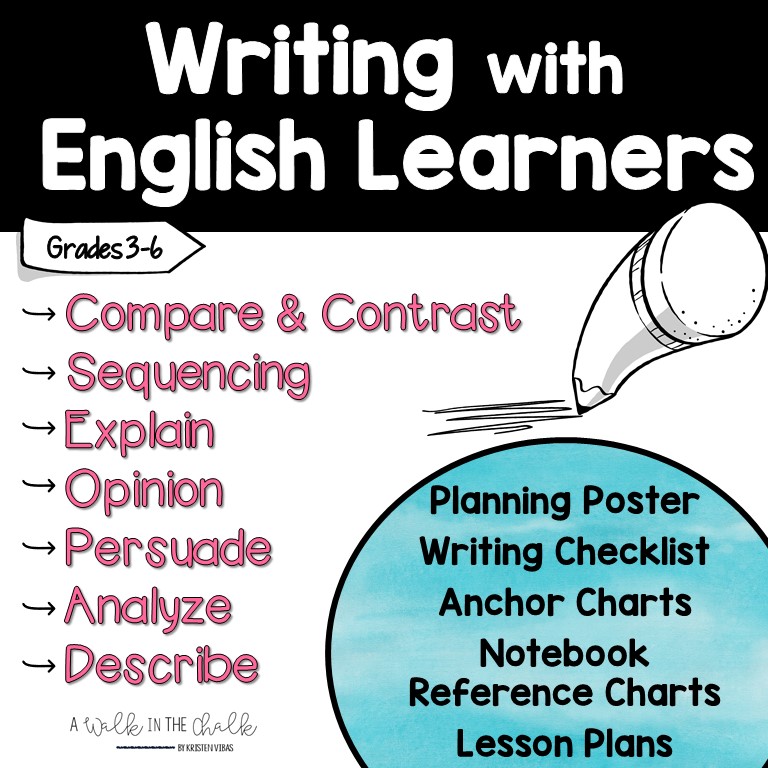An ELD Lesson Format That Makes Planning Easier
Are you looking for lesson plan ideas that incorporate all four language domains for your kindergarten and 1st grade English learners? I have a weekly system that makes ELD lesson planning easier, provides quality lessons and keeps students engaged throughout the year.
One of the key resources I use to implement weekly plans with my K-1 students is a Reading A-Z online book subscription. The reason I love using these printable books is that my students can write in them and then take them home at the end of the week. Don't have a subscription? That's OK! This system still works;)
Step 1 is determining students' starting points for reading. My beginning readers/beginning English learners usually start at level aa or A.
Step 2 is choosing a book that has relevant and meaningful vocabulary, as well as a repetitive sentence structure. This is important because I want students to build their everyday vocabulary and become familiar with basic sentence structure, as well as exposure to sight words in context.
Here are some of my favorite titles...
Main Components of Weekly ELD Lessons
These lesson components don't change. Each day of the week is devoted to certain components which makes lesson planning much more manageable.
- build or tap background knowledge
- vocabulary
- reading
- oral language
- writing
- word work
Additional components:
- sight words
- sentence structure
- letter formation
There's enough variety throughout the week that my K-1 students stay engaged and even look forward to the familiar structures and activities.
What's great about having a system in place is I know exactly what each week looks like and which components are taught on each day; the only thing that changes is the book.
What Does a Week of Lessons Look Like?
👉🏼 Pick an appropriate book and make enough copies for all of the students, plus and extra copy for you. I choose the double sided option for copying, that way all I do is fold the pages and staple the spine. It's super simple!
👉🏼 Tap into background knowledge. This is the first thing we do on Mondays when we start a new book, and it can be as simple as asking, "What do you know about ____?" It gets them thinking about the topic and connecting it to their prior knowledge. I do my best to choose books that my students likely already have some background knowledge of.
👉🏼 Introduce vocabulary. Before we open the book, I lay out pictures from the book. Then we practice identifying the pictures and saying the words.
*I always print one copy of the book in color, then cut out the pictures or illustrations to use as vocabulary cards. I also write the vocabulary words on index cards or cut up sentence strips for a post reading matching activity.
Once we've practiced identifying and saying the vocabulary words, it's time to open the book.
👉🏼 Identify a sight word- I usually identify a repetitive sight word in the book and have students hunt for and highlight the word on each page.
👉🏼 Read with a purpose. I tell the students something like, "Now we're going to read to find out... " and finish that sentence depending on what the book is about.
At the beginning of the school year, when I am reading with my beginning readers/English learners, we do echo reading or choral reading. As the weeks progress and my students' literacy and language skills strengthen, they begin reading more independently and I gradually release that support.
👉🏼 Talk about the book. This is where I can support their oral language development by asking questions about the book. I also model my own response, then they take turns sharing their thoughts and ideas.
👉🏼 Respond to reading. After reading the book, students respond to the book. There is a space in the back of the book to write, so that's were we do the writing. After writing (or before), students add an illustration and color it. Lastly, they share their writing and illustration with the group.
👉🏼 Word Work/Phonics. I always pull word work from the book. I look for a word that I can build word family words with, usually CVC words, then have students practice writing them on a white board.
Word work for my students still learning letter names and sounds looks different, so the word work activities are chosen to meet the needs of each group.
Other weekly activities are sentence structure and letter formation. For the sentence structure activity I take a repetitive sentence from the book and write it on a sentence strip, then cut apart the words. If I have 5 students in a group, then I have 5 different sentences cut apart. Each student gets one sentence and is tasked with putting the words in order, then reading the sentence aloud.
Letter formation is also an important skill we practice each week. I try to tie the weekly letter to something in the book.
Lastly, I'll sprinkle in additional activities such as letter identification, read aloud books, thematic monthly vocabulary, and games to keep each week fun and engaging. I think it's important to make learning fun, and my students seem to really enjoy this system.
 |
| Monthly Thematic Activities |
Weekly Format of ELD Lesson Components
I meet with my groups 4 times a week, 30 minutes at a time. Here's how I structure each week.
Monday - tap into background knowledge, introduce vocabulary (pictures are laid out on the table),
identify and highlight a sight word, read with a purpose, matching activity- vocabulary words
with pictures
Tuesday - review vocabulary, reread the book, sentence structure activity, write & illustrate
Wednesday - I don't see my K-1 students on Wednesdays
Thursday - reread the book (less support), word work from the book (activity depends on the group),
color their illustration and share their writing
Friday - reread the book (support only as needed), letter formation, add an additional fun activity
(game or read aloud), exit ticket out the door (a sentence from the book with no picture support)
and a high five;)
 |
| After Reading the book, students match word cards with their pictures. |
 |
| Exit ticket out the door- reading without picture support. |
This structure could be easily implemented with a variety of books; they don't have to be Reading A-Z books. But I do really like that students own their books, can write in them and take them home to read to family members each week.
Graphic organizers are another great tool for incorporating the writing component when using non-consumable books. If I didn't use this online book subscription, I'd use book sets from my school's bookroom along with some good graphic organizers.
Having a structure in place for weekly ELD lessons eliminates the guesswork from lesson planning, and that's huge! If you have a Reading A-Z subscription, try this out with your K-1 students, even K-2! If you don't have a subscription, grab some book sets and graphic organizers and do the same structure. Let me know how it works for you! 🙌🏼
Below is a monthly thematic resource bundle linked to my TPT store. I devote one week out of the month to building monthly themed vocabulary. Each month comes with printable books, a digital book to project for a shared reading, vocabulary cards, a writing activity, plus a fun BINGO game.
 |
| Each month is also sold separately |
Happy Teaching!




































No comments